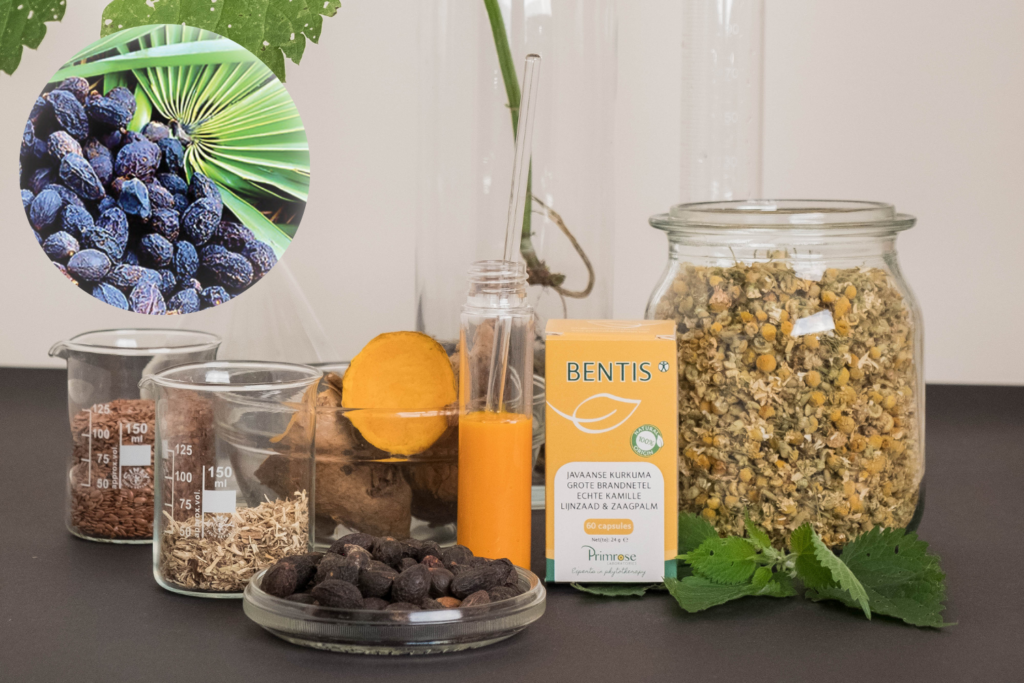Saw Palmetto’s berries have a long tradition for being used for its medicinal properties.
Let’s have a closer look at how Saw Palmetto can have supportive benefits for your prostate.
Where? What? How?
Saw Palmetto (Latin name: Serenoa repens) is a species of the serenoa family, a palm growing in the southeastern United States. Its extract is rich in fatty acids and phytosterols and is mainly known for its benefical effect on Benign Prostatic Hyperplasia (BPH), in particular testosterone-induced BPH . Furthermore, because of its antibacterial and anti-inflammatory effects, this plant extract may also help with the treatment of prostatitis.
Numerous studies have proven the efficacy and safety of Saw palmetto extracts, especially for the indication of BPH and several preparations (consisting of serenoa repens extracts only or combined with other ingredients) are commercialized. The mechanisms through which Serenoa repens exerts its effects are still elusive however several biochemical effects have been demonstrated. They include anti-androgenic effects (ao. 5α-reductase inhibition and hence reducing DHT levels), apoptosis (cell death) induction and inhibition of cell proliferation (through affecting several signalling pathways) and inhibition of the urokinase plasminogen activator. Which molecules are the main responsibles for the activity remains unclear. However, Myristoleic acid has been identified as potentially inducing apoptosis.
Multiple trials have researched the combined use of Serenoa repens and Urtica dioica for its effect on BPH and they demonstrate a significant advantageous effect over placebo and equal effects as some synthetic medicines. On top, the tolerability and safety are excellent.
REFERENCES
Willetts KE, Clements MS, Champion S, Ehsman S, & Eden JA (2003) Serenoa repens extract for benign prostate hyperplasia: a randomized controlled trial. BJU international 92:267-270
Suter A, Saller R, Riedi E, & Heinrich M (2013) Improving BPH symptoms and sexual dysfunctions with a saw palmetto preparation? Results from a pilot trial. Phytotherapy research : PTR 27:218-226
Habib FK, Ross M, Ho CK, Lyons V, & Chapman K (2005) Serenoa repens (Permixon) inhibits the 5alpha-reductase activity of human prostate cancer cell lines without interfering with PSA expression. International journal of cancer. Journal international du cancer 114:190-194
Popa G, Hagele-Kaddour H, & Walther C (2005) [Efficacy of a combined Sabal-urtica preparation in the symptomatic treatment of benign prostatic hyperplasia. Results of a placebo-controlled double-blind study]. MMW Fortschritte der Medizin 147 Suppl 3:103-108
Sokeland J (2000) Combined sabal and urtica extract compared with finasteride in men with benign prostatic hyperplasia: analysis of prostate volume and therapeutic outcome. BJU international 86:439-442
Lopatkin N, Sivkov A, Walther C, Schlafke S, Medvedev A, Avdeichuk J, et al. (2005) Long-term efficacy and safety of a combination of sabal and urtica extract for lower urinary tract symptoms–a placebo-controlled, double-blind, multicenter trial. World journal of urology 23:139-146

